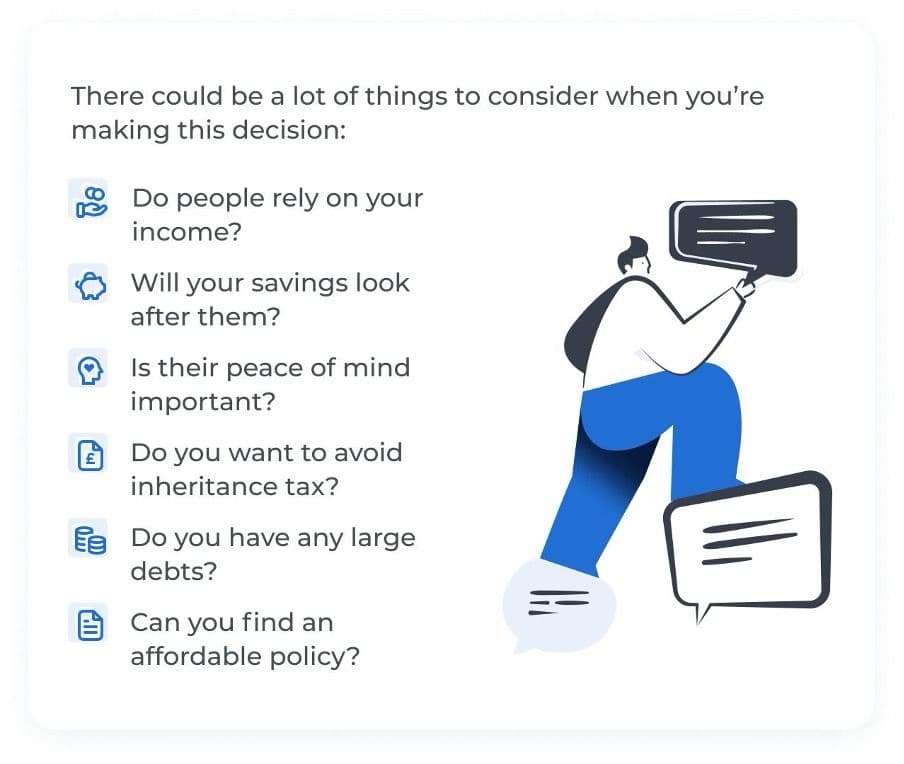What is life insurance in the UK?

What is life insurance?
For hundreds of years, life insurance has been used as a way of guaranteeing financial obligations. A person with debts or a mortgage or family to look after takes out an insurance policy on their own life, which promises to pay creditors or family an agreed sum of money if the insured person dies.
The Benefits of life insurance
Life insurance provides money for the people you leave behind, but beyond that simple purpose it has many other benefits.
Family security
A life insurance policy provides financial protection for loved ones and dependants should the policyholder pass away. It also gives peace of mind: to the policyholder because they know they’ve made sure the people they leave behind will be looked after; to their loved ones who have the comfort of financial security. Not only can a life insurance payout take care of immediate financial burdens like funeral costs, it also provides for the living expenses of those left behind.
Debt repayment
The proceeds of a life insurance policy can also be used to settle any debts – including mortgages - which will survive the death of the insured. They would otherwise become the responsibility of the insured’s estate, therefore affecting the beneficiaries.
Cash value
Policies that last for the entire length of the insured’s life are called ‘whole life’ policies, and these often contain a savings and investment element. That means the policy builds up a cash value, in addition to the payout sum, which can be used as security for a loan. It may also be possible to withdraw money from this element, although doing so will reduce the amount payable on death. Other types of life insurance policy have no cash value.
Tax advantages
Leaving money to your beneficiaries via a life insurance policy is a way of minimising their tax liability. Inheritance tax is currently payable at 40% on everything over £325,000 that passes from the estate of the deceased to the beneficiaries. That can include the proceeds of life insurance. The best way of avoiding this is to place your life insurance policy in trust. This keeps it outside your estate and allows your beneficiaries to receive the money tax-free and often more quickly than under the usual probate process.
How does life insurance work?
It’s a contract between the policy-holder and an insurance company. Between them they agree how much the policy will cost and how much it will pay out. The policy-holder pays regular premiums and in return the insurance company promises to pay an agreed sum of money if the person insured dies, provided the other terms of the policy are met. It’s possible for someone to insure another person’s life but in the vast majority of cases the policy-holder and the insured are the same person.
If the insured dies while the policy is in force, the insurance company pays either a lump sum or regular payments to the people named in the policy. These are the beneficiaries.
Who is Life Insurance for?
For the vast majority of people, life insurance is very valuable. Very few of us live an entirely solitary life, without personal, financial or family responsibilities, so the chance to continue meeting those responsibilities when we’re gone is very appealing.
The most obvious example is someone who is the main or only breadwinner in their family, because it can pay off debts and cover the family’s living expenses, but it can also be useful for people without dependents. For example, if you have adult children you might want to give them a lump sum when you die and the money from an insurance policy isn’t delayed by the probate procedure, nor is it subject to tax. It also has a role in business, where it can be used to provide funds for the continuation of a business if a key member of the team dies.
It’s no overstatement to say that life insurance could be for everyone. Occasionally it’s an obligation – perhaps as a condition of a mortgage, or for landing a particular job – but usually it’s a choice. The categories of people for whom life insurance is suitable are potentially limitless, although it’s easy to identify the most obvious.
- Tenants who rent the family home
- Homeowners with mortgages
- Parents of young children
- Older people who are thinking about their family’s future
- Carers and people with elderly dependents
- Family breadwinners
- Small business owners
- Retirees
Essentially, it comes down to anyone whose income is relied upon by others, who wants to look after people when they’re no longer around or who wishes to settle their debts when they pass.
Types of life insurance
Life insurance policies come in many forms and sub-categories. There are two primary versions, of which most types are variations:
Term life
This covers the insured for a specified period, which could be a few years or a few decades. It will pay out if the insured dies within that period.
Pros:
- Relatively low premiums
- Straightforward policies
- Flexibility to suit your needs
- Suitable for time-limited financial aims
Cons:
- No cash value, investment or borrowing element
- Cover has a fixed end date
- Premiums rise if you renew
Whole life insurance
As the name suggests, whole life insurance covers the insured for their entire life, paying out on their death at any age.
Pros:
- Covers you for life
- Builds up a cash value
- Premiums are fixed
- Helps with estate planning
Cons:
- Premiums are higher than term life
- Policies are more complex
- There may be charges for early termination
All life insurance is either a term or a whole life policy.
Joint life insurance
Commonly used by partners and spouses, this insures two lives in one policy and pays the survivor when the other insured dies, at which point the policy ends.
Joint life insurance vs single life insurance
-
The premiums for joint life policies are lower than those for two separate policies
-
Joint life can be more helpful with estate planning and inheritance tax
-
The two parties submit a single application
-
Both partners share equal cover
-
Joint policies usually leave the surviving partner without cover
-
Being insured jointly can cause complications if a couple separates or divorces
-
If one partner has health issues, the joint premiums can be higher
-
Joint life policies generally have fewer options for customisation than individual policies
Level term vs. Decreasing life insurance
If you haven’t thought about life insurance before, you may not be aware of the varieties available. For many people, their idea of life insurance is probably that of a level term policy. This promises to pay a fixed sum on the death of the insured. The amount is set when the policy is taken out and, unless it includes special conditions, that sum won’t change.
Insurance companies understand that customers have different needs, so they have introduced flexibility by creating insurance policies in which the sum assured can change over the life of the policy.
Decreasing life insurance
This is a term life policy in which the final payout decreases each year. It’s often chosen by people who have finite, quantifiable financial obligations which they want to make sure will be settled if they pass away. The clearest example is a capital repayment mortgage, which is fully paid off after a set number of years. Each monthly payment covers interest and a proportion of the original loan. Eventually the capital repayments reduce to nothing and the mortgage is discharged. A decreasing life policy can be designed to match this declining obligation so that it will yield enough money to pay off whatever remains if the insured passes away before the mortgage comes to an end. It should be noted that this won’t work for an interest-only mortgage, because the full amount of the loan doesn’t reduce and remains to be paid at the end of the mortgage term.
Although the sum assured decreases, the premiums do not. They are calculated to take account of the decreasing nature of the death benefit, so they tend to be lower from the outset than for level term or increasing term policies.
Increasing life insurance
As you’d expect, this works in the opposite way from decreasing life insurance. The amount of cover increases each year, along with the premiums. Most people who choose this do so to protect the value of the payout from the negative effects of inflation, which, over the course of a decades-long policy, can be serious. By keeping the sum assured in step with inflation, policyholders can ensure that their beneficiaries receive the full value of what’s been provided for them.
There are typically two ways of funding the increase.
-
Indexation: the annual increase is calculated according to changes in the Retail Price Index. This is the UK’s official measure of inflation.
-
Fixed percentage: the policy sets an annual percentage increase in the sum assured and the premium. This is not so closely linked to inflation but it does make budgeting easier.
Critical illness insurance
This type of policy pays out if the insured is diagnosed with an illness that’s serious (as described in the policy) or terminal. Although this isn’t life insurance, because it can pay out while the insured is still alive, it is often bought as a complement to a life insurance policy.
Pros:
- Lump sum payment if an insured illness is diagnosed
- Covers a wide range of serious illnesses
- Supplements health and disability insurance
- Helps with debt repayment and rehabilitation costs
- Reduces financial stress
Cons:
- Only covers specified illnesses
- Strict criteria must be met when claiming
- Can be expensive, particularly for older people or those with pre-existing conditions
- Usually offers a one-time-only payout
- May exclude pre-existing conditions
Life insurance for high-risk occupations
People with unusually dangerous jobs can find it hard to get life insurance. Many insurers are not prepared to take on the risk and those that are may stipulate so many exclusions and restrictions that the policy isn’t worth a great deal to the insured.
Fortunately, there are policies available for people with high risk occupations. They tend to dispense with the standard exclusions like working at height, underwater, on oil rigs, with explosives or chemicals. These might seem very specialised concerns, but an industry like the construction sector includes all of them and construction work is judged to be one of the most dangerous of all jobs. Other exclusions in standard policies includes aviation, military service and working in or near conflict zones.
A high risk occupation life insurance policy will cover you in most or all of these situations. The unusual level of risk will be reflected in the cost, of course, and premiums can be much higher compared to standard life policies. However, the ultimate cost of not having life insurance at all can be even higher.
Life insurance for high net worth individuals
Wealthy people often have more complex finances than the rest of us, which means making post-mortem provisions for their families, assets and businesses can be just as complicated. Such people are often described as high net worth individuals, or HNWIs.
In 2016 HMRC defined a HNWI as someone whose liquid assets (wealth that isn’t tied up in things like property so it can be easily accessed) exceed £10 million. That figure needs updating but for now it’s the definition in general use.
Life insurance can play an important part in passing on assets to the insured beneficiaries without incurring 40% inheritance tax. It also helps with business succession planning, equalisation of inheritance amongst heirs and philanthropic aims.
Paying for your policy: Age-based premiums vs. level premiums
If you choose a simple term or whole life policy in which the sum assured neither decreases nor increases then your monthly premiums are likely to stay the same throughout. As we’ve already seen, increasing life cover means increasing premiums.
There is also something called an age-based policy, which is a form of increasing life insurance. The main difference is that the increases in your premiums are recalculated each year according not to inflation but to your age.
How is that different in effect from an ordinary increasing life policy? Well, in terms of the increasing cover you receive it may not be, but when it comes to the premiums there’s a financial advantage. Age-based premiums tend to start at a lower level than other policies which can be very helpful if you’re concerned about the cost in the early years.
Age-based premiums can also be relevant if you take out life insurance later in life. In these circumstances your risk is higher than if you started in your 20s or 30s, and even a level term policy bought when you're older might require you to pay higher premiums each year. This is a good reason to plan ahead and think about arranging your life insurance as early as possible.
Other important considerations
If you’ve made the decision to take out life insurance, there are a number of other things to think about.
The beneficiaries of your life insurance
When you take out life insurance you choose your beneficiaries – that is, the person who will receive the pay-out, or the people who will share it. Their names will be listed in your policy documents and when you pass away, they will be able to make a claim from the insurance company. It’s important to keep your list of beneficiaries up to date so you can be sure your wishes are carried out.
How to choose the right life insurance
Getting life insurance can seem overwhelming. It can be a long process with providers whose policies have to be set up over the phone and it can take a heavy emotional toll. After all, it isn’t easy to face your own mortality, but we think it's an important insurance to have in place.
There are many things to consider before taking out a life insurance policy, but once you’ve made the decision, here are some tips to help you make the best choice of policy.
How much do you want your policy to pay out on your death?
Obviously, this depends entirely on your circumstances. You might have debts that would be left unpaid without insurance. On top of that you may want to work out a sum of money that would help your dependents maintain their lifestyle and for how long you’d like this to last.
How much are you able to pay each month?
Life insurance policies are not as expensive as you might think, but it’s a regular financial commitment like a direct debit for Netflix or the gym. You need to budget for this because if you find yourself unable to keep up the payments, your policy may end and you’ll no longer be covered.
Is the option of withdrawing cash from your policy important to you?
Most whole life policies have a cash value, meaning you can borrow money against them or even cancel the policy and take the money out. This isn’t the case with all life insurance policies.

FAQs
When you apply for life insurance, you’ll be asked a series of questions about your past and current health. Your answers are used to assess the level of risk your insurer is taking on. If you are experiencing mental health problems or you have done in the past, it doesn’t mean the insurer will automatically reject your application. It may simply be a factor in their calculation of your level of cover and your monthly premiums.
It depends on the condition. If you are suffering from an illness that is likely to shorten your life significantly then they may decline to insure you. Alternatively they might exclude that condition from insured causes of death. If you have a condition that isn’t life-threatening or life-shortening then they may be willing to insure you without exclusions or with only limited restrictions.
It’s entirely up to you. Anyone you choose can benefit from your life insurance, but most people designate their closest family and dependants.
It usually starts once the insurer has approved your application, you’ve paid your first premium and your policy has been issued. In some cases it may start from the date when your application is approved. This is something you can ask when you’re looking for the right insurance provider.
Not necessarily. It can depend on any or all of these factors: The insurance company’s standard procedure, the terms of the policy, whether you have chosen a high level of cover, your age, your health and medical history
Inheritance tax is only payable if you leave more than £325,000 when you die. However, if you’re concerned about it and you want to make sure your beneficiaries won’t have to pay inheritance tax on the payout from your life insurance policy you can place it in trust, which means it’s owned by the trustees and doesn’t form part of your estate.
Life insurance claims are usually paid within a few weeks of the death of the insured. It’s important to find out from your provider how long it’s likely to take.
Death by suicide is often covered by life insurance, but most policies won’t pay out if it occurs in the first year or two of the policy. The rationale for this is that someone contemplating taking their own life may be taking out the insurance to gain a financial advantage from a conscious act. Life insurance is designed for unforeseeable events and insurers take the view that a suicide in the first year or two may have been planned, but after that it’s unlikely to be directly related.

Related resources

Turning Customer Curiosity Into Confidence: Theea's Coverage Calculator
Introducing Theea's Coverage Calculator: the intuitive insurance tool inspired by thousands of customer conversations that turns anxiety into tailored advice and confusion into confident choices.

Meet Your Newest Eleos Perks
We’re expanding our perks with two new additions designed to turn good intentions into healthy habits. Discover everything you can get for free with an Eleos policy.

Income protection for smokers
If you smoke, you may have a tough time getting income protection insurance, but it’s not impossible.

Do doctors need income protection?
A career as a doctor may be a vocation but you still have to earn a living

Do trade union members need income protection?
What financial support will your union give you if illness or injury forces you to stop working?

Getting Britain Working Again?
On 18th March 2025, the Secretary of State for Work and Pensions announced controversial disability benefit reforms